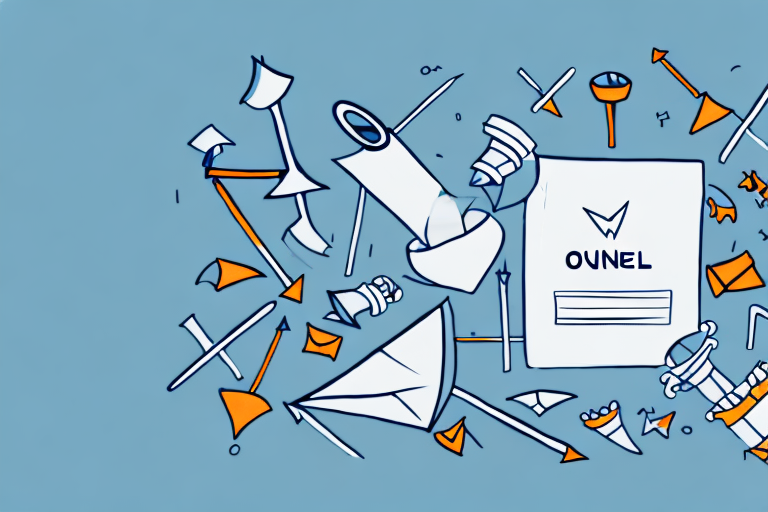Understanding the Recruitment Funnel: A Step-by-Step Guide
Recruiting new talent is an essential aspect of any successful business. It’s a continuous process where you channel your efforts into finding, attracting, assessing, and hiring the most qualified candidates. However, many organizations struggle to streamline this process, leading to an inefficient and drawn-out hiring process. To overcome these obstacles, it’s important to understand the concept of a recruitment funnel and how to optimize it. In this guide, we’ll explore the essential components of the recruitment funnel, ways to enhance its efficiency, and crucial metrics to track to measure its success.
The Importance of the Recruitment Funnel
The recruitment funnel is a visual representation of the hiring process, from the initial stages of reaching out to potential candidates, to onboarding and training the new hires. It is essential because it simplifies and breaks down the hiring process into distinct and manageable stages. By following each stage of the funnel, recruiters can quickly evaluate and identify the most qualified candidates while keeping the process organized. Moreover, a well-optimized recruitment funnel helps reduce the time and cost of hiring, boosts the employer brand, and ultimately leads to more successful hires.
Streamlining the Hiring Process
The recruitment funnel can help streamline the hiring process by clearly defining each step. This allows you to identify bottlenecks and inefficiencies at each stage, making it easier to make informed decisions and improvements.
One way to streamline the process is to narrow down your ideal candidate profile. This can be achieved by identifying the key skills, experience, and qualifications that are necessary for the job. Once you have a clear idea of what you’re looking for, you can create a job description that accurately reflects the role’s requirements.
Next, establish a timeline for each stage, from candidate sourcing to onboarding. This ensures that the recruitment process moves efficiently and that all stakeholders are aware of the expected timeframe. By setting realistic deadlines, you can keep the process moving while also reducing the risk of delays.
Finally, leverage technology to automate and streamline tasks such as resume screening and scheduling interviews. This can save time and reduce the risk of human error. By automating repetitive tasks, recruiters can focus on high-value activities, such as building relationships with candidates and conducting in-depth interviews.
Identifying Bottlenecks and Improving Efficiency
The recruitment funnel also helps you identify bottlenecks and inefficiencies at each stage. For instance, if there’s a high dropout rate after the initial stage of the recruitment process, you may need to revise your candidate sourcing and outreach methods. Similarly, if most qualified candidates drop out just before the job offer stage, you may need to re-evaluate your compensation or offer terms.
Additionally, you can identify areas where you need to streamline the process, such as automating repetitive tasks or reducing the number of interviews required. Improving efficiency at each stage of the recruitment funnel helps reduce the time and cost of hiring while increasing the chances of successful hires.
Enhancing the Candidate Experience
The candidate experience is becoming increasingly essential in the recruitment process. Candidates who have a positive experience are more likely to accept a job offer, recommend your organization to others, and become strong ambassadors of your brand.
The recruitment funnel can help you enhance the candidate experience by providing a structured and transparent hiring process. Respond to candidates timely, provide feedback and keep them updated on the process. This helps to build trust and rapport with candidates and ensures that they feel valued throughout the process.
Additionally, clearly communicate your employer brand during the recruitment process to attract suitable candidates and provide a positive experience. This can be achieved by highlighting the company culture, values, and benefits. By providing a positive candidate experience, you can increase the chances of successful hires and build a strong employer brand.
Components of the Recruitment Funnel
The recruitment funnel comprises four critical components:
Sourcing and Attracting Candidates
The initial stage of the recruitment funnel involves sourcing and attracting candidates. At this stage, you must identify the best channels to reach potential candidates, including job boards, social media, and networking events. It’s essential to understand your target audience and tailor your messaging to appeal to them. For instance, if you’re recruiting for a tech startup, you may want to focus on social media platforms like LinkedIn and Twitter, where tech-savvy individuals are likely to be present.
Creating a compelling and transparent job description is also crucial at this stage. Your job description should align with your organization’s values and desired skills and qualifications. It should also provide potential candidates with a clear understanding of what the role entails and what they can expect from your organization.
By sourcing and attracting suitable candidates, you increase the odds of finding the best fit for your organization. However, it’s worth noting that this stage can be time-consuming and require a significant investment of resources.
Screening and Assessing Applicants
After sourcing and attracting candidates, the next stage involves screening and assessing applicants. This stage involves analyzing resumes, cover letters, and other application materials to identify the most qualified candidates.
Using applicant tracking systems (ATS) can help automate and simplify this stage, freeing up time for more important tasks, such as conducting interviews and assessments. ATS software can also help you identify patterns in candidate data, such as the most effective sourcing channels and the qualifications that are most commonly found in successful candidates.
It’s worth noting that this stage can be challenging, as you’ll likely receive a large number of applications that need to be reviewed and assessed. However, taking the time to screen and assess applicants thoroughly can help you identify the best candidates for your organization.
Interviewing and Evaluating Prospects
The interviewing stage is perhaps the most crucial stage of the recruitment funnel. At this stage, you need to use structured interview techniques to evaluate candidates objectively.
Be sure to prepare a list of interview questions and invite multiple stakeholders to participate in the interview process. This approach can help ensure that you evaluate candidates from multiple perspectives and reduce the risk of bias in the evaluation process.
Additionally, use supplemental assessments, such as technical assessments and personality tests, to evaluate candidates holistically. These assessments can help you identify candidates’ strengths and weaknesses and assess their fit with your organization’s culture and values.
It’s also essential to provide candidates with a positive interview experience. This experience can help candidates feel more engaged and excited about the opportunity to work for your organization.
Making Offers and Onboarding New Hires
The final stage of the recruitment funnel involves making offers and onboarding new hires. Once you’ve identified the most qualified candidate, you need to craft a competitive offer that aligns with your organization’s compensation structure.
It’s essential to communicate the offer clearly and transparently, including details about salary, benefits, and other compensation-related information. This approach can help ensure that candidates feel valued and appreciated and are more likely to accept the offer.
After the candidate accepts your offer, proceed to the onboarding stage, where you provide new hires with the necessary resources, information, and training to integrate into your organization successfully.
Effective onboarding can help new hires feel more engaged and productive in their roles. It can also help reduce turnover rates and improve overall employee retention.
In conclusion, the recruitment funnel is a critical process for any organization looking to attract and retain top talent. By following these four components, you can increase your odds of identifying the best candidates for your organization and ensuring that they have a positive experience throughout the recruitment process.
Optimizing Each Stage of the Recruitment Funnel
Optimizing each stage of the recruitment funnel involves implementing effective strategies to increase efficiency and reduce the time and cost of hiring. The following are some optimization strategies:
Implementing Effective Sourcing Strategies
Effective sourcing strategies are critical to the success of any recruitment process. Diversifying your recruitment channels is key to reaching a wider pool of candidates. This can include job boards, social media platforms, and industry-specific websites. Additionally, creating a strong employer brand can help attract top talent. Highlighting your company culture, mission, and values can help candidates understand what it would be like to work for your organization. Leveraging employee referrals is another effective sourcing strategy. Encouraging current employees to refer their friends and colleagues can help you find qualified candidates who are a good fit for your organization.
It’s important to monitor your sourcing metrics such as cost per hire to evaluate the effectiveness of each sourcing channel. This allows you to make data-driven decisions about which channels to invest more time and resources in.
Leveraging Technology for Efficient Screening
Technology can be a game-changer when it comes to screening candidates. Applicant tracking systems (ATS) can help you streamline screening and resume handling tasks. ATS can help you identify the best candidates more efficiently and reduce hiring bias based on factors, such as gender and race. Additionally, video interviews can be an effective way to screen candidates remotely and save time and resources on in-person interviews.
Conducting Structured Interviews
Structured interviews involve using a standardized set of questions to evaluate candidates. This approach reduces hiring bias and ensures consistency in the interview process across different stakeholders. Structured interviews also enhance the candidate experience by providing a clear understanding of the evaluation criteria. Additionally, using behavioral-based interview questions can help you assess a candidate’s skills and experience in a specific area.
Crafting Competitive Offers and Streamlined Onboarding
Once you have identified the best candidate, you need to make a competitive offer to secure their acceptance. This includes offering a competitive salary and benefits package. It’s important to research industry standards and salary ranges for the position to ensure that your offer is competitive.
Additionally, the onboarding process is critical to the success of new hires. Streamlining the onboarding process can help new hires integrate seamlessly into your organization and become productive more quickly. This can include providing a clear onboarding plan, assigning a mentor or buddy to help the new hire navigate the organization, and providing access to training and development opportunities.
By implementing these optimization strategies, you can increase the efficiency of your recruitment process, reduce the time and cost of hiring, and attract and retain top talent.
Measuring the Success of Your Recruitment Funnel
Measuring the success of your recruitment funnel is critical to continuous improvement. The following are some metrics to track:
Key Performance Indicators (KPIs) to Track
Track metrics such as time to fill, cost per hire, and candidate dropout rate to evaluate the effectiveness of each stage of the recruitment funnel. Additionally, survey candidates to evaluate their experience and gather feedback on how to improve the recruitment process.
Analyzing and Interpreting Recruitment Metrics
Analyze recruitment metrics to identify areas of weakness and bottlenecks in the recruitment process. Once identified, adjust your strategies accordingly to streamline the recruitment process and improve the candidate experience.
Continuous Improvement and Adjusting Strategies
Finally, continuously adjust your strategies to ensure that they align with the ever-evolving recruitment landscape. Use the insights gathered from recruitment metrics and candidate feedback to improve the process and ultimately achieve a more optimized recruitment funnel.
Conclusion
Understanding the recruitment funnel is essential to hiring high-quality candidates efficiently and effectively. By breaking down the recruitment process into manageable stages, organizations can streamline the hiring process, reduce the time and cost of hiring, and enhance the candidate experience. By continually optimizing the recruitment funnel and measuring its success, organizations can stay competitive in the job market and attract top talent.


